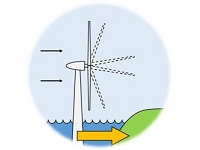Ultra-Large Wind Turbine

Technology Description:
The team led by the University of Virginia (UVA) will design the world’s largest wind turbine by employing a new downwind turbine concept called Segmented Ultralight Morphing Rotor (SUMR). Increasing the size of wind turbine blades will enable a large increase in power from today’s largest turbines – from an average of 5-10MW to a proposed 50MW system. The SUMR concept allows blades to deflect in the wind, much like a palm tree, to accommodate a wide range of wind speeds (up to hurricane-wind speeds) with reduced blade load, thus reducing rotor mass and fatigue. The novel blades also use segmentation to reduce production, transportation, and installation costs. This innovative design overcomes key challenges for extreme-scale turbines resulting in a cost-effective approach to advance the domestic wind energy market. The team includes world’s experts at the National Renewable Energy Laboratory (NREL) and Sandia National Labs (SNL) working with world-class faculty and students at the Colorado School of Mines, University of Colorado (Boulder), University of Illinois (Urbana-Champaign), and UVA.
Potential Impact:
If successful, the team will develop the world's largest wind turbine design that could transform the wind energy market and enable the potential for integration of wind energy in the U.S. electrical grid, ultimately reducing reliance on fossil-fuel based electricity generation.
